Scottish Dog Breeds
The world of Scottish dog breeds is just as ancient, fascinating, convoluted, and sometimes surprising, as everything Scottish seems to be.
All the dog breeds that originated in Scotland have physical traits that reflect the climate, environment and historical era of their birthplace and, not surprisingly, Scotland's earliest dogs were no-nonsense, hard working breeds who earned their keep, while also much loved companions.
You'll easily recognize some of the popular dog breeds who are featured here, some of them may be less familiar, and others you've likely never even heard of.
Because this site is about anything and everything Scottish, the historical information was something I found really interesting.
I hope you enjoy the whole article, but if you're especially interested in a specific breed, feel free to skip right to that section from the list below.
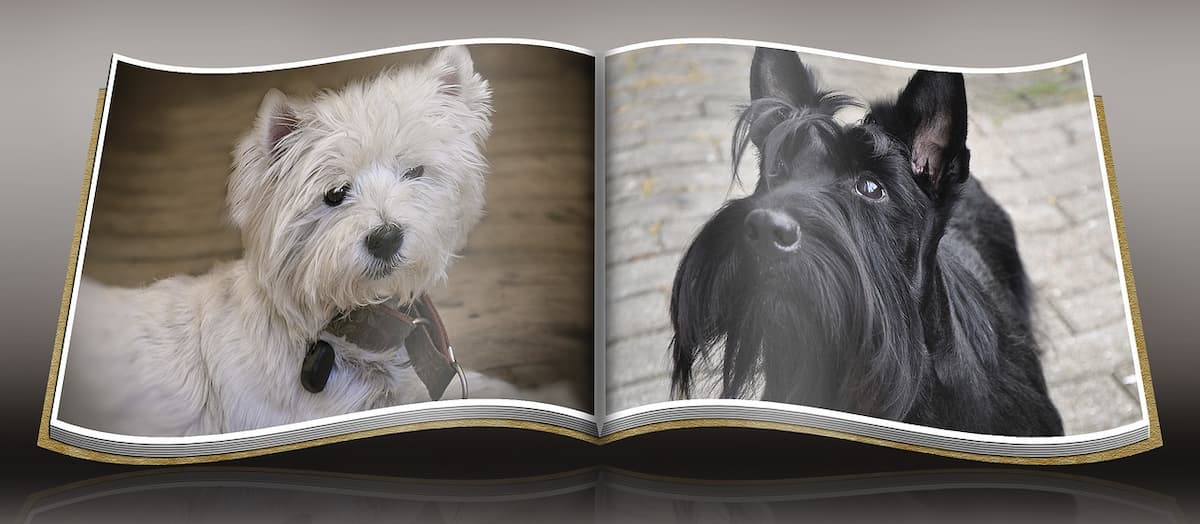
I'm Scottish through and through, and a lifelong dog owner and dog lover, so this was a fascinating article to research.
Admittedly, I got a little geeky over it and did a LOT of deep diving into the origins and histories of these captivating Scottish dog breeds.
There was WAY too much information to include on an overview page like this, but over the next few months I plan to add an in-depth look at the history of each individual breed, building a separate page for each one.
If you'd be interested in those pages, bookmarking THIS page may be a good idea. You can even use the Grow.me feature (teal icons bottom right of every page) on our site to start collating and bookmarking your favorites across the web.
List of dog breeds from Scotland
Scottish dog breeds are all from working dog groups, and are either terriers, herding dogs or hunting dogs.
Here are the fifteen Scottish breeds which are still in existence today:
- Bearded Collie (herding)
- Border Collie (herding)
- Border Terrier
- Cairn Terrier
- Dandie Dinmont Terrier
- Golden Retriever (hunting)
- Gordon Setter (hunting)
- Rough Collie (herding)
- Scotch Collie (herding)
- Scottish Deerhound (hunting)
- Scottish Terrier
- Shetland Sheepdog (herding)
- Skye Terrier
- Smooth Collie (herding)
- West Highland White Terrier
There are also three breeds of dog who originated in Scotland, but were only in existence for a relatively short time, and are now extinct:
Many lists of Scottish dog breeds include the Bloodhound.
But, although bloodhounds have been bred in Scotland, it’s believed that they originated in Belgium or France. Records show them originating around AD1000 in a Belgian monastery.
About Scottish Dog Breeds
Although there is a significant difference in size, and looks, between the dogs in these different groups, there are also many similarities.
Working dogs in Scotland, particularly in the Scottish Highlands and islands, needed a weather-proof coat to be able to withstand harsh temperatures, plus a strong body and a courageous heart to handle the equally harsh terrain.
That’s why the rough, double coat of a wire-haired breed like the terrier (strong, fibrous outer coat with soft warm undercoat) or the long, hardy double coat of a Collie were predominant.
These dogs also needed to be as sturdy, energetic, alert and brave as the Scottish farmers, shepherds, crofters and hunters they belonged to.
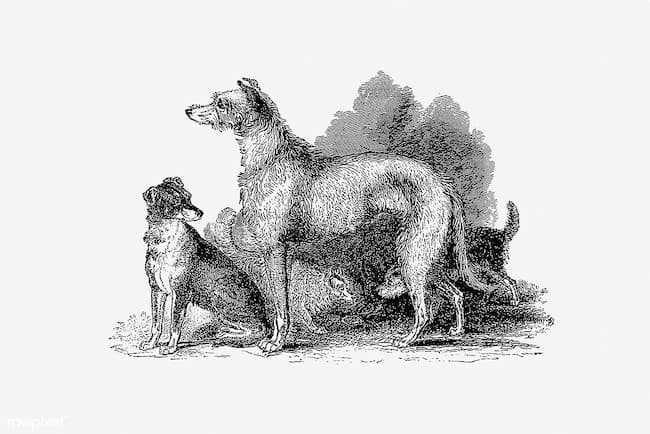 CC Attribution (CC BY 4.0)rawpixel.com
CC Attribution (CC BY 4.0)rawpixel.comAll the individual dog breeds that originated in Scotland came from a mixture of indigenous native dogs who, over centuries, were intermixed with breeds brought to Scotland by seamen, traders and invaders.
Over time these became separated out into the three basic groups - terriers, herding dogs and hunting dogs.
It took a long, long time for the individual breed types to be created, using selective breeding for certain physical traits. Some emerged from the general pool earlier than others. Some stood the test of time with little change, others didn't.
Six of the eighteen Scottish breeds on this page are on the Kennel Club's (British) 'Vulnerable Native Breeds' list. Breeds on this list have declined in numbers to dangerously low levels and are at risk of becoming extinct.
Three more are already extinct, and a fourth (the Scotch Collie) came very close to disappearing, and although it has been revived/recreated, numbers are still very small.
That's ten breeds, more than half of the recognized Scottish dog breeds either lost to the world, or in danger of being so.
Maybe it's my Scottish blood, or maybe it's my squishy, dog-loving heart, but it makes me sad to think of so many of Scotland's small group of native breeds either being gone, or moving in that direction :(
The Hard Working Dogs of Scotland
There are a huge number of working dogs, of all different types in the history of Scotland. It's estimated that by the late 1800's there may have been as many as 1000 recognizably different varieties, including what were called 'curs', which meant mixed breeds.
The word ‘Terrier’ comes from the Latin word ‘Terraii’ which means ‘workers of the earth’ and this describes terriers perfectly, because the breed as a whole was used to chase, trap, follow and dig out all sorts of rodents, vermin and other small animals such as badgers, foxes etc.
The earliest written reference to the word ‘Terrier’ may be in a poem written by Gace de la Vigne in 1360 (in his native French), translated it says:
'Go fetch him in the ground
With his good terriers
That we put in the burrows'
Terriers of one kind or another have existed in Scotland for an incredible length of time.
According to the AKC, there is a tiny carving of ‘a short-legged, long-headed, prick-eared, cobbily build dog, barking on a wheelbarrow’ on a Scottish Highlands farm wall. Experts believe it could date as far back as 200 AD!
In general, terrier breeds are active dogs, bold, tenacious, stubborn, scrappy, energetic and independent dogs. Some are ‘softer’ than others in terms of personality, but overall they’re a force to be reckoned with.
Herding dogs are incredibly intelligent and agile, they can learn to follow complicated commands and when not in a working home need a job to do and something to occupy their minds and bodies.
In pet/family situations they often excel in formal obedience training, agility, and sports such a flyball.
The value and importance of farmers, crofters and shepherds owning good working dogs in Scotland is summed up beautifully in the words written by James Hogg in 1824.
Here's an excerpt taken from his work ‘The Shepherd’s Calendar’.
‘Without the shepherd’s dog, the whole of the open mountainous land in Scotland would not be worth sixpence. It would require more hands to manage a stock of sheep, gather them from the hills, force them into houses and folds, and drive them to markets, than the profits of the whole stock were capable of maintaining.’
Hunting dogs are intelligent, sensitive and eager to please. They work well as team players and are very responsive to their owners/handlers.
Scottish herding and hunting breeds have also been in Scotland for a very, VERY, long time, and there is anecdotal evidence that long haired working and herding dogs existed in Britain as far back as 2000 BC.
Historically speaking, the Scottish farmers, hunters, crofters and families who owned dogs were interested only in whether a dog could do the job they needed it to do.
Those dogs who did well were bred from, for their working ability, not because of how they looked (other than ensuring they were physically suited to the work), and in general, written records were not kept.
Most of the patchwork of history that has been put together surrounding the origins of Scottish breeds is from oral accounts, stories, legends and, in some cases old paintings, poems and (a handful of) books or written documents.
There are many, MANY days worth of research on my part that went into this page (and the upcoming individual breed pages), but that’s nothing compared to the decades, sometimes even hundreds, of years of work that has been put into recording breed histories and stories by the dedicated breeders and enthusiasts from the earliest written records until now.
Looking at it now, it seems that extricating the history and origins of each breed from the melting pot of different types was akin to trying to untangle Christmas lights while blindfolded!
Even the most fanciful of stories, myths and legends generally grow up around a kernel (or maybe a large rock) of truth. Sort of where there's smoke there's fire scenario.
It's also impossible to be sure which of Scotland's native dog breeds is the oldest, even though fans and enthusiasts of several of them claim that the honor belongs to their breed!
Bearded Collie
The Bearded Collie has been known by several names over the centuries, including the Hairy Mou'ed Collie and the Loch Collie. Today it's often called just 'the Beardie' by those who love it.
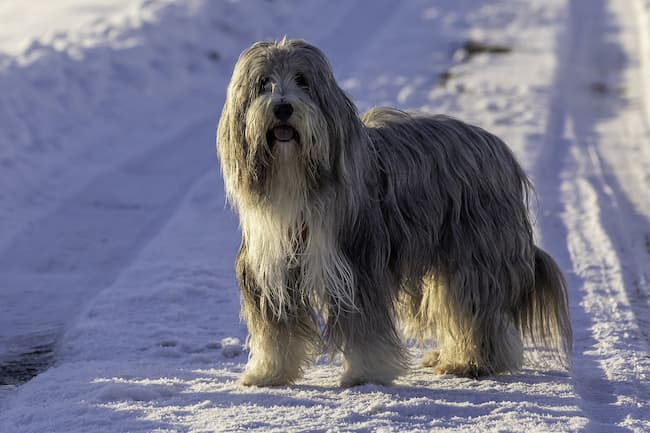
Bearded Collies are working dogs, originally bred to herd and drive the livestock of Scottish farmers, crofters and shepherds.
It's believed that the Bearded Collie existed in Scotland as early the 1600's, and possibly even in the 1500's.
The Bearded Collie was recognized by the Kennel Club in Britain in 1959.
Bearded Collies were imported to the US in the 1950’s and the breed was recognized by the American Kennel Club in 1976.
The Bearded Collie is one of several Scottish dog breeds who are on the Kennel Club's 'Vulnerable Native Breeds' list.
Size (AKC): A medium sized dog. Height 20"-21" tall for females and 21"-22" tall for males. Weight between 45 and 55lbs
Lifespan: 12 years +
Color: Recognized by the Kennel Club in 17 colors including black, blue, brown, fawn, grey, slate and combinations.
Temperament: Affectionate and playful; good with children and other dogs if socialized properly; energetic and outdoorsy.
Exercise Needs: Moderate to High
Things you should know: Bearded Collies tend to bark a lot. They have long, thick coats that need daily grooming. They need daily exercise and mental stimulation.
If you'd like to take a deeper dive into the history of the Bearded Collie check out THIS PAGE.
Border Collie
The Border Collie is a popular herding breed, and today most everyone recognizes their distinctive black and white coat.
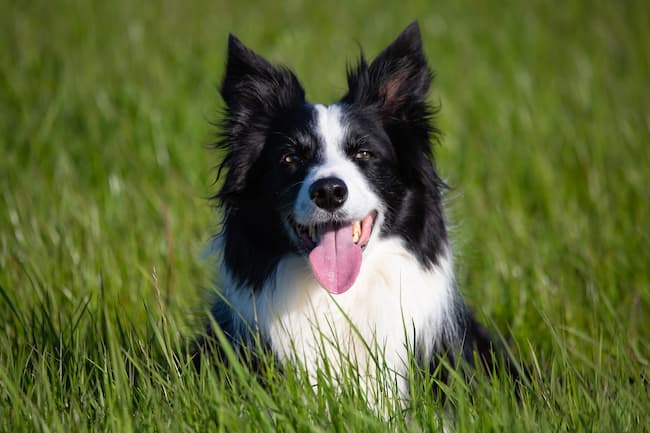
This breed is descended from the early 'Shepherd's dogs of Scotland who worked with shepherds, crofters and farmers to protect and guide their sheep in the wild and unhospitable Scottish countryside.
An interesting characteristic of the Border Collie is it's unique way of controlling it's charges. Rather than simply use his bark, or nip at their heels, the Border Collie uses a calm but intense stare which seems to intimidate the sheep without frightening them.
Today this breed doesn't just excel at herding trials and working competitions. The Border Collie is a also a star at formal obedience, agility and sports such as flyball.
The Border Collie breed was recognized by the Kennel Club in 1976, and by the American Kennel Club in 1995.
Size (AKC): A medium sized dog. Height 28"-21" tall for females and 19"-22" tall for males. Weight between 30 and 55lbs
Lifespan: 10-15 years+
Color: Even though we automatically think of black and white Border Collie coats are recognized by the Kennel Club in 50 different color combinations, and by the AKC in 21. They include combinations of black, blue, brown, red, sable, blue, merle and more.
Temperament: Affectionate and playful; extremely intelligent; quick learner; loyal; active and energetic.
Exercise Needs: High
Things you should know: Border Collies are the ultimate working dog, they NEED A LOT of exercise and mental stimulation and aren't suitable for sedentary homes. They can be nippy because of their herding origins. They have a strong drive to herd, and tend to use it on all types of livestock, smaller pets and even children. Considered to be one of the smartest dog breeds in the world.
If you'd like to know more about the history of the Border Collie, check out this page.
Border Terrier
The Border Terrier (which was also sometimes known as the Coquetdale Terrier, Reedwater Terrier) comes from the border lands, or border country, either side of the English Scottish border.
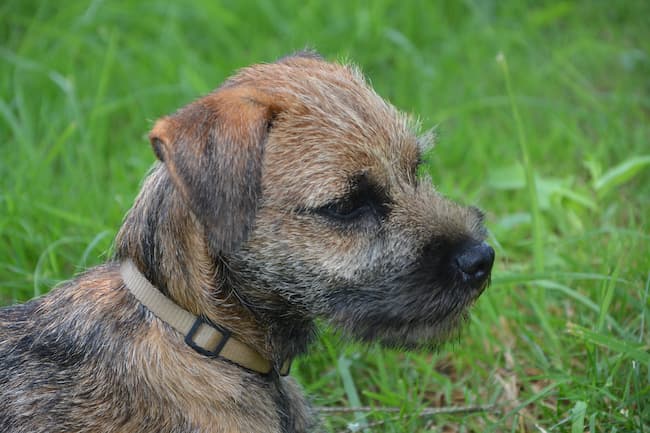
In their earliest days, small terriers like this were used by farmers to chase down the foxes who preyed on their sheep. Dogs of the Border Terrier type excelled at this.
In the 19th century when fox hunting first became a popular sport in Britain, Border Terriers joined the hounds who rode with the hunt, their job being to down underground after the fox if need be. They have slightly longer legs than other Scottish terrier breeds and were able to cover extended distances on the ground, while also being small enough to be portable.
The Border Terrier was recognized by the Kennel Club in 1920, and by the American Kennel Club in 1930
Size (AKC): A small dog. Overall height 12"-15". Weight between 11.5-14lbs for females, 13-15.5lbs for males
Lifespan: 12-15 years
Color: Recognized by the Kennel Club in 10 colors including certain combinations of blue, 'grizzle'*, red, wheaten (light tan) and tan. And by the AKC in 12 combinations of the same colors.
*Grizzle refers to a coat who's coarse outer hairs are tipped with black while the undercoat is usually red or tan.
Temperament: Affectionate and playful; active; generally good with children and strangers; fairly easy care coat; strong prey drive.
Exercise Needs: Moderate to High
Things you should know: Can be stubborn. They need regular, daily, physical and mental exercise to be happy and healthy. Inclined to chase small animals, other small pets, birds or wildlife, and cars. Low shedding, coat needs to be hand stripped.
You can take a deep dive into the history of Scotland's Border Terrier here.
Cairn Terrier
The Cairn Terrier is a brave, tenacious, hardy little dog who is one of the oldest of the Scottish Dog Breeds, originating in the Highlands as well as on the islands off the northern coast of Scotland (including the Isle of Skye which is the birthplace of the Skye Terrier).
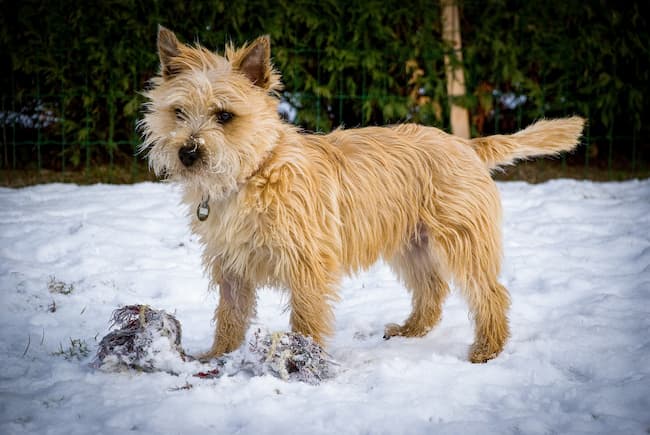
The breed got its name because of their skill at chasing small prey, such as rats and other vermin, from where they had hidden themselves, which often included the cairns (piles of rocks which often mark memorials or landmarks) which abound in Scotland.
Until the 1800's all the different terriers of Scotland were lumped together and loosely called Scotch terriers. Untangling the different individual breeds was a process, and for a time the Cairn Terrier was known as the 'Short Haired Skye Terrier'.
Even though it's a small dog, historically the spunky Cairn Terrier was also used to hunt foxes, badgers and otter.
The Cairn Terrier breed was recognized by the Kennel Club in 1910, and by the American Kennel Club in 1913.
Size (AKC): A small dog. Height 9.5" tall for females and 10" tall for males. Weight 13lbs for females and 14lbs for males.
Lifespan: 13-17 years
Color: Recognized by the Kennel Club in 17 colors including brindle, cream, black, grey, red, wheaten and combinations, and by the AKC in 15.
Temperament: Affectionate and playful; protective; courageous; feisty; can be determined and single minded.
Exercise Needs: Low to Moderate
Things you should know: Because they are protective of home and family, Cairn Terriers can be vocal and bark an above average amount. For the same reason they can be suspicious of strangers. Low grooming needs.
Learn more about the origins and history of the spunky little Cairn Terrier HERE
Dandie Dinmont Terrier
The adorable Dandie Dinmont Terrier is the rarest of the Scottish dog
breeds, and one of the very first to be recognized as a separate and
distinct breed type in the early 1700's.
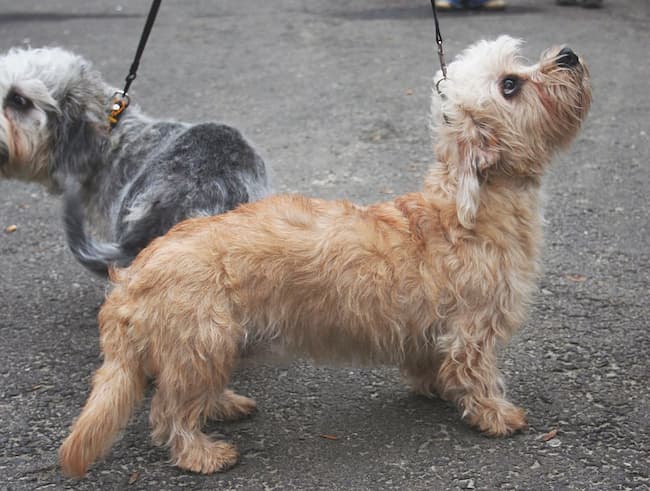 "File:Dandie Dinmont terrier suka musztardowa 2009 pl.jpg" by Pleple2000 is marked with CC BY-SA 4.0. To view the terms, visit https://creativecommons.org/licenses/by-sa/4.0/?ref=openverse
"File:Dandie Dinmont terrier suka musztardowa 2009 pl.jpg" by Pleple2000 is marked with CC BY-SA 4.0. To view the terms, visit https://creativecommons.org/licenses/by-sa/4.0/?ref=openverseThe Dandie Dinmont originated north of the Scotland/England border in the hilly border country and, like all the other terriers of Scotland, he was bred to chase and kill vermin/rodents.
If you're wondering how a terrier from no-nonsense Scotland got such a fancy name, you can thank famous Scottish writer Sir Walter Scott who by chance met, and fell in love with, this unique terrier type in the early 19th century.
He even went so far as to model a character in his book 'Guy Mannering' (published in 1815) after the farmer who had introduced him to the breed. Scott named this fictional farmer 'Dandie Dinmont' and gave him six 'Mustard & Pepper' terriers (the color of the Dandie Dinmont's coat) The book was a huge hit, and this little dog suddenly became recognizable too and people began calling it the Dandie Dinmont. The name stuck!
Sadly for this breed, it never became popular on a wide scale and breeders have been struggling to keep it alive right up until the present time.
Strangely I was unable to find out when the Dandie Dinmont was recognized by the Kennel Club (so if anyone reading this knows the truth about this I'd appreciate hearing it!) but it was recognized by the AKC in 1886.
The AKC has the Dandie Dinmont breed on their 'Vulnerable Native Breed' list which means they are at risk of extinction. I became quite attached to this unique little terrier as I learned more about him and I hope very much that he doesn't disappear from our world.
Size (AKC): A small dog. Height 8-11" tall. Weight 18-24lbs
Lifespan: 12-15 years
Color: Recognized by both the Kennel Club and the AKC in 2 colors, mustard and pepper. Mustard is a fawn/red/brown and Pepper is Dark blue or black to gray/silver.
Temperament: Affectionate and friendly; gentle; alert and protective of family; easy to train.
Exercise Needs: Low to Moderate
Things you should know: Dandie Dinmonts love to dig, and can make an impressive hole in a short space of time. Can be stubborn and independently minded at times. Low shedding coat. Their sweet expression can melt your heart.
Learn more about the history and origins of the Dandie Dinmont Terrier HERE
Golden Retriever
The Golden Retriever is another one of the more famous Scottish dog breeds. The Golden is hugely popular around the world, and for good reason.
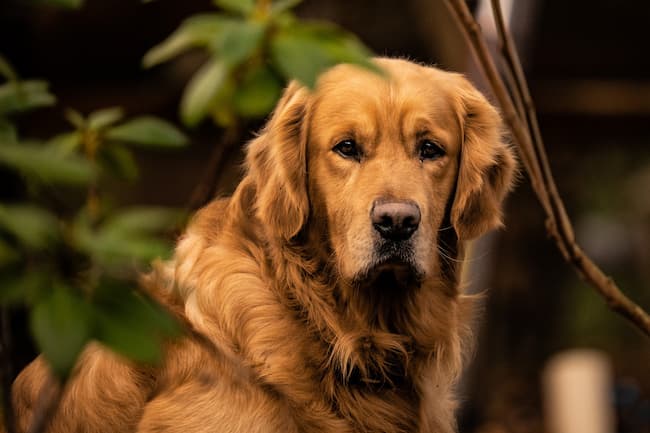
The Golden Retriever was first developed in Scotland during the 19th century, where it was bred to retrieve fowl who were killed during hunting expeditions.
It's origins include the wavy coated retriever and the, now extinct, Tweed Water Spaniel, and it's possible that one or two other breeds were also in the mix.
Although the Golden Retriever is a strong, athletic and active dog, bred as a to work, the Golden Retriever has proven to be very versatile, and its happy, confident personality makes this breed a great family pet.
Recognized by the Kennel Club in 1913 and by the American Kennel Club in 1925.
Size (AKC): A large dog. Height 21.5"-22.5" tall for females and 23"-24" tall for males. Weight 55-65lbs for females and 65-75lbs for males
Lifespan: 10-12 years
Color: Recognized by the Kennel Club in Cream, Gold and Golden, and by the AKC in Golden, Light Golden and Dark Golden
Temperament: Happy, energetic, affectionate. Friendly to all and good with children and other dogs. Intelligent and extremely responsive to training.
Exercise Needs: Moderate to High
Things you should know: The beautiful Golden Retriever coat sheds a lot and their grooming needs are high. Generally a quiet dog in terms of vocalization and not generally protective. Needs a lot of exercise and mental stimulation. Loves water.
Learn more about the Scottish origins and history of the Golden Retriever HERE.
Gordon Setter
'Setters' are bird dogs, bred to locate and mark the position of fowl for their human hunting companions.
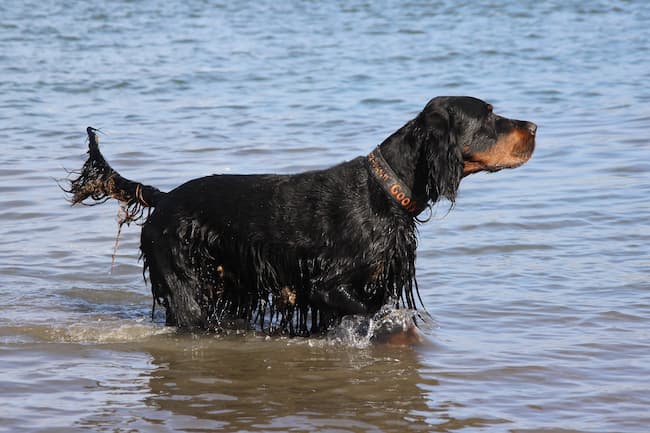
They were used in Scotland (likely from as early as the 16th century) when hunting grouse, quail, pheasant and partridge in the rocky and rugged Scottish hills and glens.
The individual and distinctive Gordon Setter breed developed from these early bird dogs and is named after Alexander, the fourth Duke of Gordon who concentrated on breeding setters in his kennels at Gordon Castle during the late 18th and early 19th century.
Alexander is considered the founding breeder of the Gordon Setter which was officially given his family/clan name.
The biggest of the setter breeds, the Gordon has a beautiful and distinctive black and tan coat, and these big, strong, athletic dogs love exercise and work, are are also affectionate and playful.
The Gordon Setter breed was recognized by the Kennel Club in 1924 (prior to that it was known as the 'Black and Tan Setter' which became a KC recognized breed in 1872).
In 1884 the AKC recognized the breed as the 'Gordon Castle Setter', amending that to be the Gordon Setter in 1893.
The Gordon Setter is on the Kennel Club's 'Vulnerable Native Breeds' list.
Size (AKC): A large dog. Height 23"-26" tall for females and 23"-26" tall for males. Weight 45-70lbs females and 55-80lbs males
Lifespan: 12-13 years
Color: Recognized by the Kennel Club and the AKC in only one permissible color... Black and Tan
Temperament: Bold, protective, adaptable, and very affectionate. Active, energetic and intelligent.
Exercise Needs: High
Things you should know: Gordon Setters can be 'drooly'. They're big, bouncy, eager dogs and need to be taught to be careful around small children or the elderly. Extremely loyal and loving with their family.
Rough Collie
You may visualize the Rough Collie better if I say 'Lassie', because the multiple dogs who played Lassie over the years made this beautiful herding dog famous, and recognizable on a wide scale.
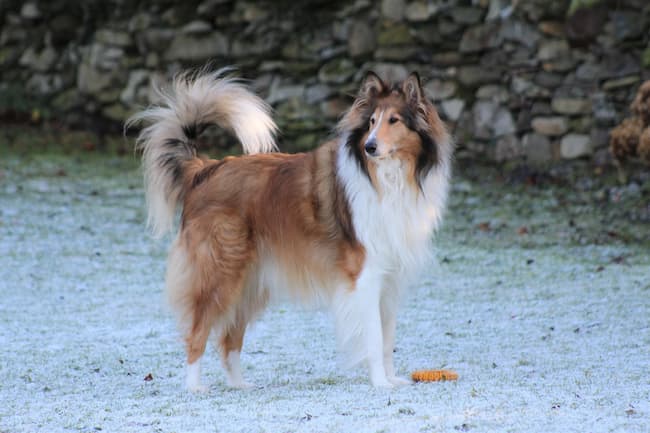
Descended from the melting pot of herding dogs which existed in Scotland during the 18th and 19th century, and for quite a while it was simply known as the Scotch Collie.
In the very late 1800's and early 1900's, selective breeding led to physical changes in the face and coat of the collie, and today's show Collies look considerably different to the working dogs they descended from.
In spite of it's rather fancy looks, the Rough Collie is still a herding dog at heart. Smart, friendly, energetic, and eager to please this breed this breed is good with children, pets but can sometimes they can be a little nervous around strangers.
The Kennel Club recognizes both the Rough and the Smooth Collies as separate breeds.
The Rough Collie was recognized by the Kennel Club in 1895 (as was the Smooth Collie). Ten years earlier the AKC recognized both varieties under one breed name, 'Collie'.
Size (AKC): A medium sized dog. Height 22"-24" tall for females and 24"-26" tall for males. Weight 50-65lbs for females and 60-75lbs for males.
Lifespan: 12-14 years
Color: Recognized by the Kennel Club in 3 colors, Blue Merle, Tricolor and Sable and White, and by the AKC in 10 colors including Black, White and Tan (which is Tricolor), blue, sable, white and combinations of those colors along with Merle.
Temperament: Athletic, intelligent, playful, good with children and quick to learn.
Exercise Needs: Moderate to High
Things you should know: Rough Collies have the sheepdog tendency to herd smaller animals (even children), they're also vocal and can bark quite a bit. Their coat required daily grooming and regular professional grooming is a plus.
Scotch Collie
The Scotch Collie is different from the rest of the Scottish Dog Breeds on this page, because it is both an old, and a new, breed. Let me explain.
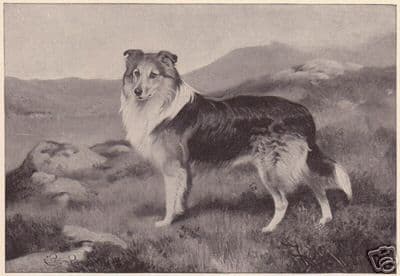 Collie circa 1896
Collie circa 1896Sourcing photographs of the original Scotch Collie proved to be very difficult, and although the above image is dated 1896 you can already see the resemblance to the modern day Rough Collie in terms of facial features. I'm going to keep looking for a vintage image of the original herding collies of Scotland, and of course it needs to be one that isn't copyrighted. It's a challenge!
The Rough Collie, Smooth Collie, Bearded Collie and Border Collie all descended from the native collie-type dog who lived and worked in Scotland hundreds of years ago. These were the original Scotch Collies.
As breeders began to focus on using selective breeding to create several new types of Collies, the original Collie of Scotland slipped under the radar and nearly disappeared,
There was some interest in trying to revive the breed in Britain during the early 1900's, but it wasn't able to get enough traction and failed.
Fortunately, early in the 20th century, certain people in the USA were paying enough attention to stop this ancient breed from becoming extinct (the Tweed Water Spaniel and the Blue Paul Terrier were not so lucky).
In a relatively short period of time some dedicated breeders and enthusiasts have helped to recreate the original Scotch Collie type, albeit with a new name... The Old Time Scotch Collie.
As yet this 'new' (and yet old) breed hasn't been recognized by the Kennel Club or the AKC.
Size (According to the Old Time Scotch Collie Association): A medium sized dog. Height 17"-23" tall for females and 19"-25" tall for males. Weight 32-70lbs for females and 35-80lbs for females
Lifespan: 12 years +
Color: All traditional Collie colors are permissible including Sable, Black and White, Tricolor, Blue Merle.. white markings are allowed with all colors in the traditional locations.
Temperament: Obedient, intelligent, protective, confident. Supremely loyal. Affectionate. Double coat requires regular grooming.
Exercise Needs: Moderate to High
Things you should know: The traditional Scotch Collie is a stable, hardworking and loving breed which makes it a good fit for both working and family life (providing it gets plenty of exercise and mental stimulation).
Scottish Deerhound
The Scottish Deerhound (also known as the Royal Dog of Scotland, and at one time, The Scottish Wolfdog) is a truly ancient breed.
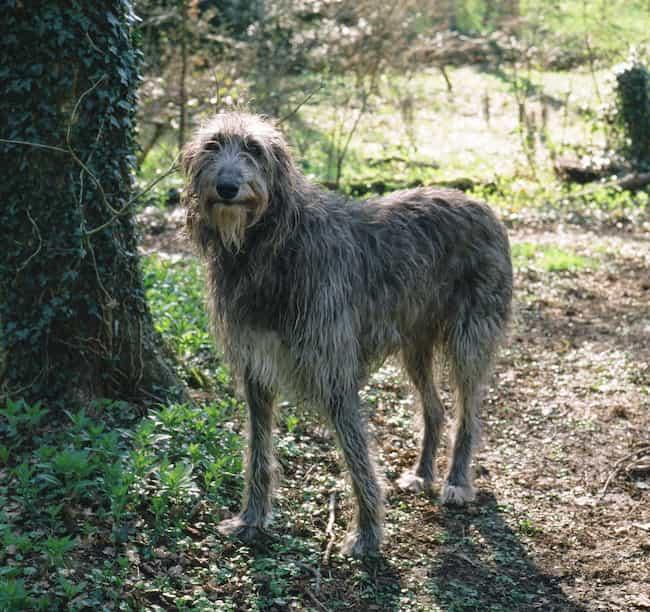 “Alfie aka Dogrates , Scottish Deerhound and Philosopher" by adamnsinger is marked with CC BY-ND 2.0. To view the terms, visit https://creativecommons.org/licenses/by-nd/2.0/?ref=openverse
“Alfie aka Dogrates , Scottish Deerhound and Philosopher" by adamnsinger is marked with CC BY-ND 2.0. To view the terms, visit https://creativecommons.org/licenses/by-nd/2.0/?ref=openverseIt likely lived alongside the Picts and Gales before Scotland (first known as the Kingdom of Alba) was officially founded in the 9th century and was originally used to hunt down wolves, and a little later the native red deer. There is also evidence that the Scottish Deerhounds ancestors may have existed as early as the 1st century.
These large, long legged and moderately slender, rough-coated dogs were sometimes referred to as the Scottish Greyhound, Rough Greyhound or Highland Deerhound.
Like many Scottish dog breeds, the Scottish Deerhound almost went out of existence at one point, for this breed it was in the 1700's and due to the Highland Chieftains putting restrictions on breeding and ownership of these dogs.
The breed survived, but is on the Kennel Club's Vulnerable Native Breeds list because numbers are still dangerously low.
Recognized by the AKC in 1886.
Size (AKC): A large dog. Height upward of 28" tall for females and 30"-32" tall for males. Weight between 75-95lbs for females and 85-110lbs for males
Lifespan: 8-11 years
Color: Recognized by the Kennel Club in 8 colors including combinations of black, blue, grey, brown and brindle and by the AKC in only 4 colors: brindle, gray, gray brindle, and blue gray.
Temperament: Extremely affectionate and gentle. Usually very accepting of other dogs. Mid range in terms of protectiveness, openness to strangers and trainability.
Exercise Needs: Moderate to High
Things you should know: The Scottish Deerhound is a quiet breed, not prone to barking without good cause. Extremely fast and shouldn't be allowed off leash in public places due to it's desire to run and chase. Doesn't require a lot of grooming.
Scottish Terrier
Originally known as the Aberdeen Terrier or Scots Terrier, the Scottish Terrier (or Scottie as it's often affectionately called) is one of the oldest Scottish dog breeds.
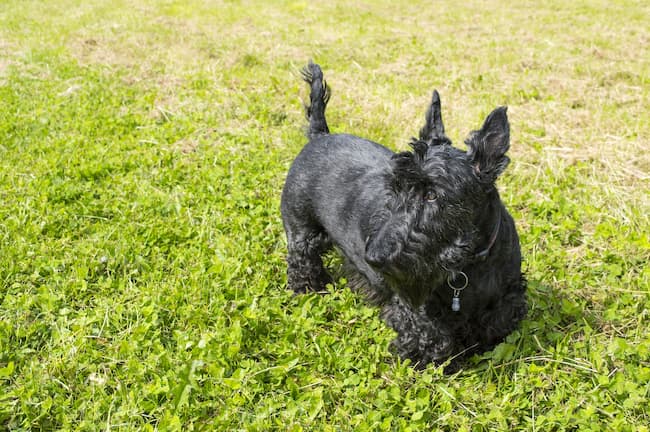
As were all terriers in Scotland, the Scottish Terrier was originally bred to chase and hunt rodents and larger vermin, which at that time included badgers and even foxes.
In 1675, a pack of terriers owned by the first Earl of Dunbar were nicknamed the Diehard Pack, because of their courage and tenacity. This name is still appropriate today as the sturdy little Scottie is a bold, stubborn, independent dog.
For various reasons, the Scottish Terrier has managed to remain consistently popular through the ages and although not a breed that you're likely to see on the street too often, it still has a lot of admirers and is not on the KC's endangered list.
Recognized by the AKC in 1885.
Size (AKC): A small dog. Height 10" tall for both males and females. Weight 18-21lbs for females, 19-22lbs for males
Lifespan: 12 years +
Color: Recognized by the Kennel Club in 4 colors: black, black brindle, brindle, wheaten and by the AKC in 6 colors: black, brindle, red brindle, wheaten, black brindle, silver brindle.
Temperament: Affectionate and playful. Very protective of home and family. Needs mental stimulation and moderate exercise to stay happy and healthy.
Exercise Needs: Moderate
Things you should know: Scottish Terriers tend to bark a lot. Inclined to chase cats and other small animals. Can be stubborn. Need daily at-home grooming and professional grooming is recommended.
Shetland Sheepdog
Also known as the Sheltie (and historically as 'Toonie dogs'), the
Shetland Sheepdog originated in the rocky and rugged Shetland Isles,
located off the north coast of Scotland.
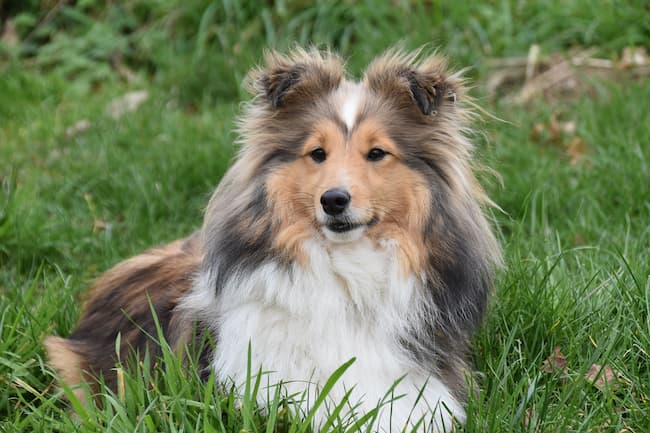
For a number of reasons the Shetlands are known for producing animals that are smaller in size than those on the Scottish mainland and the Sheltie is basically a miniature Collie. It looks a lot like the Rough Collie with some modifications created by selective breeding and it's success as a show ring type dog.
As well as being important working dogs on the Shetlands, these sheepdogs were also valued as family companions, their pint-sized bodies being a good fit for laps and as footwarmers!
The gorgeous coat of a Shetland Sheepdog is likely the result of both the spitz-type dogs from Scandinavia who are believed to be part of it's original ancestry, and breeding practices which favor that coat.
This super smart, sweet and little energetic dog is among the most popular breeds to originate in Scotland and and makes a great all round family pet.
Recognized by the Kennel Club in 1909 and by the AKC in 1911.
Size (AKC): A small dog. Height 13"-16" and 15-25lbs for both males and females.
Lifespan: 12-14 years
Color: Recognized by the Kennel Club in 9 colors including black and tan, black and white, blue merle, sable, tricolor and certain combinations of these colors. The AKC recognizes this breed in 6 combinations of black, white, tan, blue merle and sable.
Temperament: Affectionate, playful dogs who are good with children and other dogs, although they tend to be cautious with strangers. Very smart, eager to please and easy to train. Make good watch dogs due to their protectiveness around home and family.
Exercise Needs: Moderate to High
Things you should know: Like most working herding dog breeds, Shetland Sheepdogs need plenty of exercise and mental stimulation to keep them happy and healthy. They tend to bark, a lot. Their thick coats need daily grooming.
Skye Terrier
Another island breed, the Skye Terrier originated on the Isle of Skye in the Inner Hebrides.
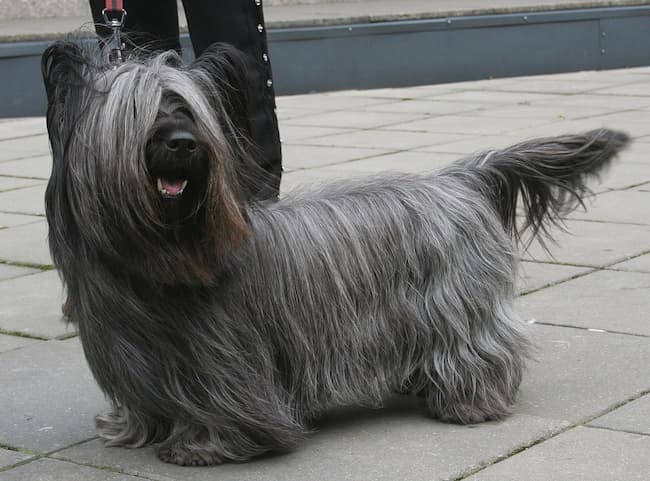 "File:Skye terrier 800.jpg" by Pleple2000 is marked with CC BY-SA 3.0. To view the terms, visit https://creativecommons.org/licenses/by-sa/3.0/?ref=openverse Attribution for single Skye Terrier
"File:Skye terrier 800.jpg" by Pleple2000 is marked with CC BY-SA 3.0. To view the terms, visit https://creativecommons.org/licenses/by-sa/3.0/?ref=openverse Attribution for single Skye TerrierOn these northern islands, small, sturdy, hardy terrier type dogs were used to help protect flocks from predators who were chased off by the larger herding dogs, and took shelter in burrows, holes and rock piles.
A unique aspect of the Skye Terriers history is the suggestion that Scandinavian dogs brought to the Isle of Skye by Vikings may have featured in their ancestry. A look at the Swedish Vallhund does show a similarity in body type and ear set. Of course, as with all Scottish dog breeds, the history of each is shrouded in a certain degree of mystery.
The famous dog, 'Greyfriars Bobby', whose statue and monument sits opposite Greyfriars Kirkyard in Edinburgh, was a Skye Terrier.
Both Mary Queen of Scots (in the 16th century) and Queen Victoria (in the 19th century) were fans of the breed, which helped to boost it's popularity. It continued to be fairly popular throughout the 1800's but this dwindled over the decades and in spite of the best efforts of many very active and dedicated breeders, the Skye Terrier is now on the Kennel Club's Vulnerable Native Breeds list.
Recognized by the AKC in 1887.
Size (AKC): A small dog. Height 9.5" tall for females and 10" tall for males. Weight 35-45lbs for males and 'slightly lighter' for females
Lifespan: 12-14 years
Color: Recognized by the Kennel Club in 9 colors including black, cream, grey, silver and both shades and combinations of those colors. Recognized by the AKC in 10 colors including Black, White and Tan (which is Tricolor), blue, sable, white and combinations of those colors along with Merle.
Temperament: Loyal and extremely affectionate; good with children and other dogs if socialized properly; brave and tenacious.
Exercise Needs: Moderate
Things you should know: Can be slow to warm up to strangers. Benefits from early, and regular, socialization. Has a tendency to be stubborn, strong willed and independent. Like to chase cats and other smaller animals/pets.
Smooth Collie
Descended from the old herding dogs of Scotland, the origins and history of the Rough Collie and the Smooth Collie are one and the same up until the late 1800's.
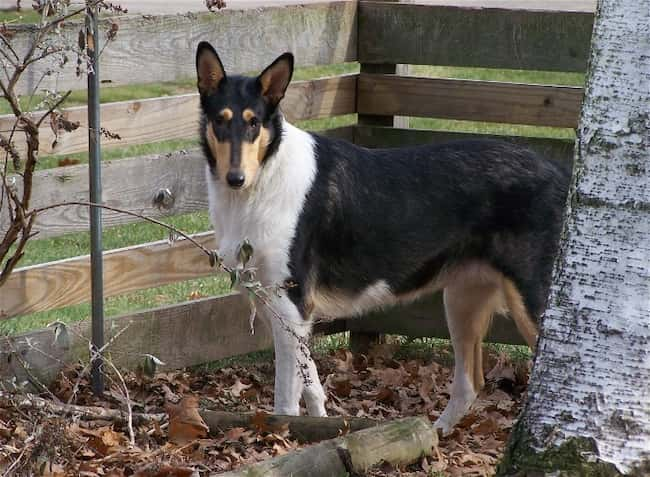 "Far Point Rescue - Mystic our current foster" by Ferlinka Borzoi (Deb West) is marked with CC BY 2.0. To view the terms, visit https://creativecommons.org/licenses/by/2.0/?ref=openverse
"Far Point Rescue - Mystic our current foster" by Ferlinka Borzoi (Deb West) is marked with CC BY 2.0. To view the terms, visit https://creativecommons.org/licenses/by/2.0/?ref=openverseAt this time, selective breeding (and perhaps a little greyhound blood) was used to create what is essentially two varieties of the same dog, with the only real difference being the length and type of coat.
Queen Victoria was a fan of Scottish dogs and owned many terriers and collies over the years. A Smooth Collie named 'Sharp' is said to have been one of favorites.
In fact, up until 1994 the Rough and Smooth Collies were considered to be the same breed, and then in 1994 the Kennel Club separated them in to two individually recognized breeds.
However, in the USA, even now the AKC doesn't recognize them as two separate breeds, and they are judged according to the exact same breed standard, but with different requirements for each type in terms of coat.
The Smooth Collie has always seemed to languish in it's sister breed, the Rough Collie's, shadow, most likely because of the latter's glamorous coat. Sadly, it is yet another of Scotland's dog breeds that is on the Kennel Club's Vulnerable Native Breed list.
Recognized by the AKC in 1885 as simply the Collie.
Size (AKC): A medium sized dog. Height 22"-24" tall for females and 24-"26" tall for males. Weight 50-65lbs for females and 60-75lbs for males.
Lifespan: 12-14 years
Color: Recognized by the Kennel Club in 3 colors: blue merle, sable and white, and tricolor. Recognized by the AKC in including black, blue, brown, fawn, grey, slate and combinations.
Temperament: Gentle, sweet, affectionate, playful and happy; extremely intelligent; easy to train; athletic
Exercise Needs: Moderate to High
Things you should know: Smooth Collies need less grooming than the Rough type, once a week is often enough. As all herding dogs do, they need adequate exercise and mental stimulation to keep them healthy and happy. A good choice for a family pet in a family that enjoys outdoor activities.
West Highland White Terrier
The West Highland White Terrier is a little dog who has been the owner of many names over the centuries.
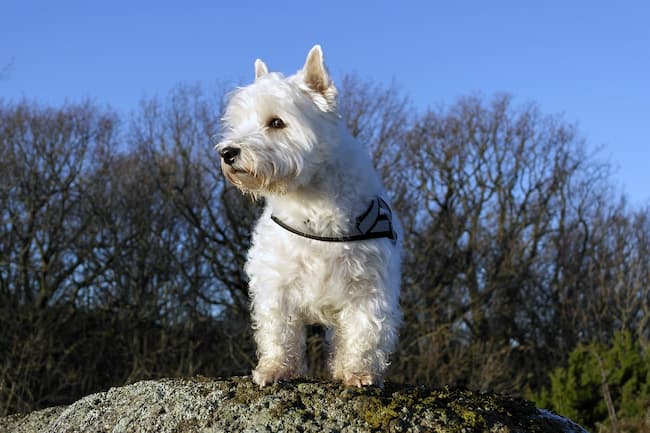
In line with the ancient, and tangled, history of Scottish dog breeds, the Westie (as it's often affectionately called) has, at one time or another, been known as the Poltallach Terrier, White Scottish Terrier, White Cairn Terrier, Roseneatch Terrier and Pittenweem Terrier.
The individual Scottish terrier breeds that we know now all descended from what were called 'earthe dogges' used to hunt down rats and other small (and sometimes not so small) vermin.
Individual terrier breeds began to emerge from the shared gene pool in the late 1800's and early 1900's.
Some quickly became popular and managed to maintain that right up until today, others weren't so lucky. The bright eyed West Highland White Terrier is one of the former, and is one of the most enduringly popular of Scotlands home-produced terrier breeds.
Recognized by the Kennel Club in 1907 and by the AKC in 1908
Size (AKC): A small dog. Height 10" tall for females and 11" tall for males. Weight between 15 and 20lbs for both sexes.
Lifespan: 13-15
Color: As their name suggests, West Highland White Terriers are recognized by both the Kennel Club and the AKC in only one color.. white.
Temperament: Sturdy, strong and independent; affectionate, playful and friendly; intelligent and courageous.
Exercise Needs: Moderate to High
Things you should know: Westies have well developed protective instincts, and the tendency to be vocal about them, so they can be noisy. Like all terriers they can be stubborn and determined. Good with children and open to strangers, but often wary of other dogs.
Extinct Scottish Dog Breeds
The origins of Scotland's dog breeds are stretch back into history, some as far as the first century, so it's sad but not really surprising that a few of them didn't make it as far as the 21st century.
The Blue Paul Terrier
The history and origins of the Blue Paul Terrier (also known as the Blue Poll or Poll Terrier) are even more hazy than those of many other Scottish breeds and very little is known about it.
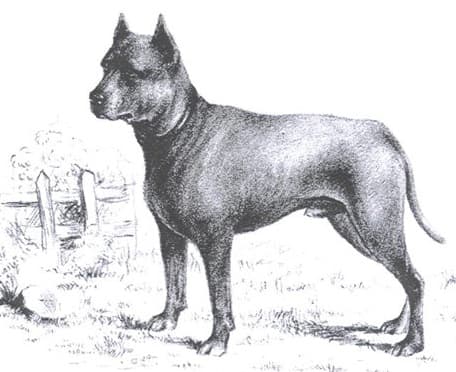
Possibly this is because the breed existed for such a short time, appearing on the scene in the 1800's, and yet gone by the mid 1900's, meaning there aren't a lot of records associated with it.
The Blue Paul Terrier didn't look like the other Scots terriers, either in terms of size or coat type, and it was bred as a fighting dog rather than a working dog.
Paisley Terrier
The Paisley Terrier (also known as the Clydesdale Terrier or the Glasgow terrier) originated in the Paisley area (in the Scottish Lowlands).
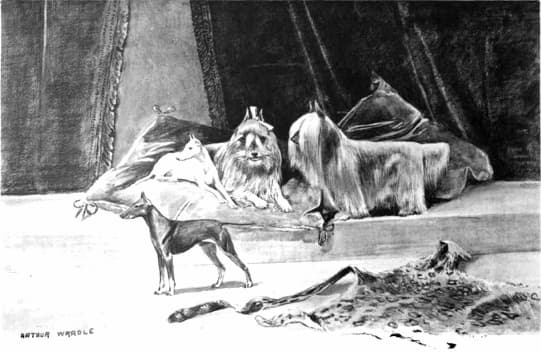
As with the Blue Paul Terrier, unlike most of the native Scottish dog breeds, the Paisley Terrier existed for a very short period of time.
Differentiating it from the Skye Terrier is difficult, as they were so similar in appearance, and it's existence appears to overlap with both the Skye and Dandie Dinmont terriers and the Yorkshire Terrier (who many believe descended from the Paisley Terrier).
So... was it actually a breed in it's own right? Or just a stepping stone between the Skye Terrier and the Yorkshire Terrier?
Whatever the truth of the situation, terriers who were referred to as Paisley's or Clydesdale's definitely existed during the later part of the 1800's into the early 1900's, but were extinct by the end of WWII, most likely even earlier.
Tweed Water Spaniel
The Tweed Water Spaniel (who may have also been called the Ladykirk Spaniel) was a hardy, industrious, athletic, tireless and affectionate working dog who's bloodlines came from the water dogs who lived and worked on the banks of the River Tweed and the coast of the Berwick Sea in the 1800's.
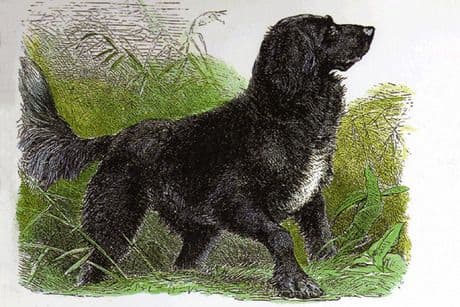
This area is in the Borderlands which stretch north and south of the Scotland/England border.
The first written record of the Tweed Water Spaniel describes a brown, curly coated dog who looked more like a retriever than a spaniel.
These dogs were the constant companions and work partners of the fisherman of the area, and their courage, strength, endurance and water resistant coats were suited perfectly for such hard, and sometimes dangerous work.
The Tweed Water Spaniel is believed to be one of the ancestors of today's Golden Retriever, but sadly it slipped into extinction at some point during the early 20th century.
- Home
- Scottish Dog Breeds